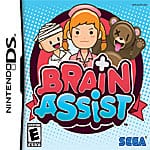One Half of A Brain,
One Half of A Game
If you’ve been in a biology class, you know about brain lateralization. But just in case it has been awhile or you weren’t paying attention, let me refresh your memory. Brain lateralization refers to the concept that different sides of your brain perform different functions.

The left side is responsible for things like logic and algebraic math, and the right side is responsible for things like creativity, intuition, and geometric math. It is generally accepted that most people have a more dominant side of their brain, and the web is littered with some fairly accurate tests to gauge which side of your brain is more dominant. Brain Assist is a game that focuses on right brain exercises. It is important to note that this game does not profess to train your brain per se, that if you are right-brained you will not get any use out of this title. I am right-brained myself and still found some of the more challenging levels difficult. Brain Assist is definitely an interesting game, but what makes it different in the ever-expanding genre of “brain” games? Well, to put it bluntly, not too much.
There are two main modes in Brain Assist: evaluation and single player. Evaluation mode is probably the more useful of the two and puts your brain through a five-stage obstacle course and then gives you a grade at the end. After you have gotten your grade, you can check out your results and look at suggested ways to improve using single-player mode. Single-player mode is comprised of ten different mini-games (the same ones you saw in evaluation), which you can use to practice and improve. Examples of such games include “Count Mania,” where you have to order numbers displaced throughout the screen, and “Quick Numbers,” which challenges you to trust your instincts and recall numbers that flash quickly on the screen. My personal favorite was a game called Pi and Thagoras which challenges you to take a shape on the top screen and recreate it on the bottom screen. But this is probably due to my love of all things geometric and not necessarily any real innovativeness on the game’s part.

The trouble with this game is that while these same ten mini-games are fun, they get a little boring after awhile. And while there are mechanisms in place that make these mini-games progressively harder as you go along, there’s not too much that will keep your interest in this game for more than a few weeks.
The only redeeming quality of this game is the fact that it has multiplayer. So if you have a friend who could benefit from some right-brain exercise, then this is the perfect game to play together. There are several ways to play with a friend. You can both go through the evaluation mode and see who has the stronger right-brain, or you can play cooperatively and measure the combined strengths of your right-brains.

All of the mini-games control using the touch screen, and this control is well-suited for this type of game. There’s no real drawing or speaking like there was in Brain Age; this one just has you tapping the correct answer.
Visuals in this game are pretty good and get the job done in terms of gameplay. Right-brain problems are easily laid out, and the visuals never hamper the gameplay, which is definitely a good thing. On the other hand, however, it’s not really that much of an amazing feat either. One thing that sort of disturbed me in this game was the “nurse” characters that are supposed to guide you through your brain assistance. I think they are supposed to look cheery, but instead they come off looking…evil.

Sound in this game is not that big of a deal, which is a good thing because if there were any distracting music, then it would have definitely hindered the gameplay. The game also makes very simplistic ringing or buzzing noises when you get answers right or wrong, which is actually quite useful when you are playing a timed game and don’t always have time to look down and see if you got answers wrong or right.
Overall, Brain Assist is a pretty novel game idea, but 10 mini-games are just not enough to make a game experience feel complete. Perhaps if this game was bundled with a left brain exercising game, or if it simply had a little bit more to offer, then it could have been a great game. I certainly like the concept and enjoyed the chance to revel in my all my right-brained glory, but I just wish it felt more complete.
RATING OUT OF 5 RATING DESCRIPTION 3.5 Graphics
Decent enough, but nothing really stands out. 3.0 Control
The game utilizes touch screen to answer questions. There’s nothing really innovative about it. 3.0 Music / Sound FX / Voice Acting
Music is barely noticeable, which is a good thing when you’re trying to concentrate. No voice acting or sound effects. 3.0
Play Value
Once you play through the two evaluation modes, you might get some satisfaction out of the single mini-game play. But there are too few modes here, and it gets repetitive quickly.
3.1 Overall Rating – Fair
Not an average. See Rating legend above for a final score breakdown.
Game Features:
